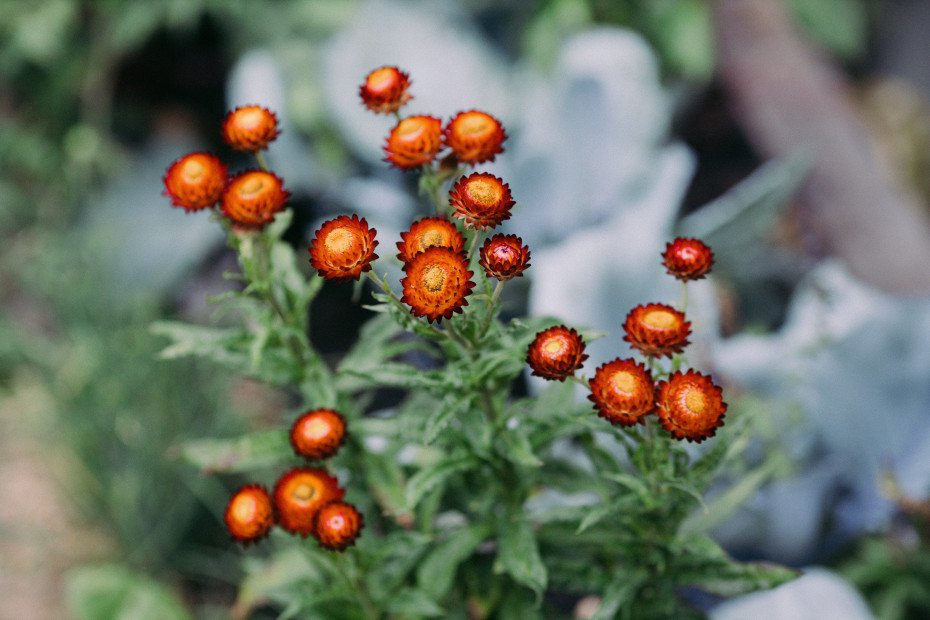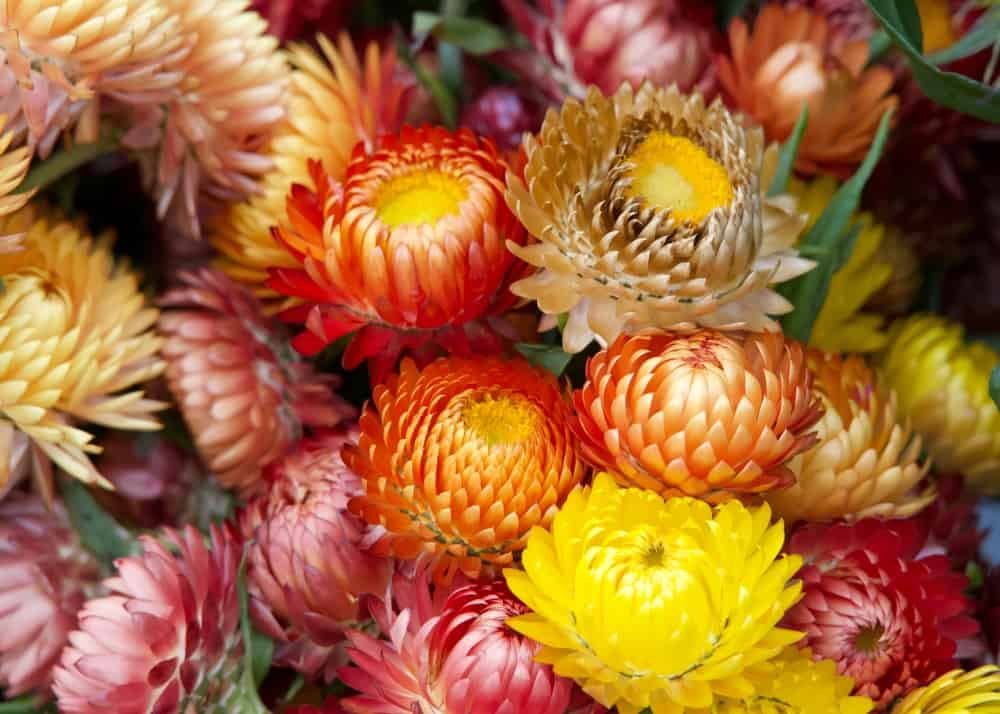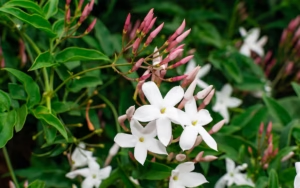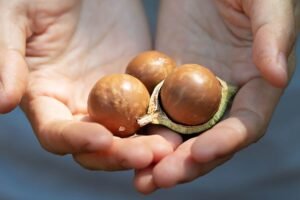Strawflowers are vibrant, long-lasting blooms that are perfect for gardens, dried flower arrangements, and even containers. Known for their ability to hold their color and shape, strawflowers are a favorite among gardeners and florists alike. In this comprehensive guide, we will explore everything you need to know to successfully grow and care for strawflowers. From planting to pruning and dealing with pests, this blog post has all the details you need.
Let’s begin with a quick overview of the essential information about strawflowers:
| Common Name | Strawflower |
|---|---|
| Botanical Name | Xerochrysum bracteatum |
| Family | Asteraceae |
| Plant Type | Annual or short-lived perennial |
| Mature Size | 1-3 feet tall, 1-2 feet wide |
| Sun Exposure | Full sun |
| Soil Type | Well-drained, sandy, loamy soil |
| Soil pH | Neutral to slightly acidic (6.0 to 7.5) |
| Hardiness Zones | 8-11 (USDA) |
| Native Area | Australia |
| Toxicity | Non-toxic to humans and pets |
Strawflower Care
Caring for strawflowers is relatively simple, making them a great choice for beginners and experienced gardeners alike. These plants are drought-tolerant, sun-loving, and low-maintenance. Here are the key care instructions for growing healthy and beautiful strawflowers:
Sunlight Requirements
Strawflowers thrive in full sun. They require at least 6-8 hours of direct sunlight each day. If you are growing them indoors or in partial shade, they may not bloom as profusely, and their stems can become weak and leggy. Always plant strawflowers in a bright, sunny spot to maximize their growth and flowering potential.
Soil Conditions
Strawflowers prefer well-drained soil. Sandy or loamy soils are ideal because they do not retain excess water, which can lead to root rot. If your garden has clay soil, consider amending it with compost, sand, or perlite to improve drainage.
The ideal soil pH for strawflowers is between 6.0 and 7.5, which is neutral to slightly acidic. You can test your soil’s pH using a soil test kit and make adjustments as needed.
Watering
Strawflowers are drought-tolerant, but they still need regular watering, especially during the growing season. Water the plants deeply once a week, allowing the soil to dry out slightly between waterings. Overwatering can lead to root rot and other issues, so it’s essential to strike a balance.
During hot, dry periods, you may need to water more frequently. If you are growing strawflowers in containers, check the soil often, as potted plants dry out faster than those in the ground.
Temperature and Humidity
Strawflowers grow best in warm, dry climates. They are native to Australia, where they thrive in hot temperatures. Ideally, daytime temperatures between 65°F and 80°F are perfect for their growth.
Humidity is not a significant factor for strawflowers, but they prefer dry conditions. In humid climates, ensure good air circulation around the plants to prevent fungal diseases.
Fertilizing
Strawflowers are light feeders and do not require heavy fertilization. Applying a balanced, slow-release fertilizer at the start of the growing season is usually sufficient. You can also use compost or organic matter to provide the necessary nutrients.
Avoid over-fertilizing, as excessive nitrogen can lead to lush foliage but fewer flowers. If you notice pale or stunted growth, apply a diluted liquid fertilizer once a month.
Types of Strawflower
Strawflowers come in a variety of shapes, sizes, and colors. While the traditional varieties are known for their vibrant yellows and oranges, modern cultivars offer an even broader color palette. Here are some popular types of strawflowers:
1. Bright Bikini Series
This variety produces compact plants with bright, daisy-like blooms. It is perfect for borders, containers, and small spaces.
2. Monstrosum Series
Monstrosum strawflowers are known for their large, showy blooms. They are ideal for cutting gardens and dried arrangements.
3. Silvery Rose
This unique variety has stunning pinkish-white petals with a metallic sheen, making it a standout in any garden or bouquet.
4. Sundaze Golden Yellow
This variety features bright golden-yellow blooms that are perfect for adding a pop of color to your garden.
5. Dreamtime Jumbo
Dreamtime Jumbo strawflowers have large, vibrant blooms in shades of red, pink, yellow, and white. They are perfect for both fresh and dried arrangements.
Pruning
Pruning strawflowers is essential to maintain their shape, encourage more blooms, and keep the plants healthy. Here are some pruning tips:
Deadheading
Regular deadheading (removing spent flowers) is key to encouraging continuous blooming. Use sharp scissors or pruning shears to snip off dead blooms just above a leaf node. This will redirect the plant’s energy into producing new flowers instead of seeds.
Trimming Leggy Growth
If your strawflowers become leggy or overgrown, trim back the stems to promote bushier growth. Cut about one-third of the plant’s height, and new shoots will emerge from the base.
End-of-Season Pruning
At the end of the growing season, prune the plants back to the ground to clean up the garden and prepare for winter. This is especially important for perennial varieties.
How to Grow Strawflower From Seed
Growing strawflowers from seed is an easy and rewarding process. Follow these steps to get started:
Step 1: Start Indoors
Start strawflower seeds indoors 6-8 weeks before the last frost date in your area. Use seed trays or small pots filled with a well-draining seed-starting mix.
Step 2: Sow the Seeds
Scatter the seeds on the soil surface and gently press them down. Do not cover the seeds with soil, as they need light to germinate.
Step 3: Provide Light and Water
Place the trays in a bright location or under grow lights. Keep the soil moist but not waterlogged. Seeds typically germinate within 7-14 days.
Step 4: Transplanting
Once the seedlings have 2-3 sets of true leaves and the danger of frost has passed, harden them off by gradually exposing them to outdoor conditions. Then transplant them into the garden, spacing them 12-18 inches apart.
Potting and Repotting Strawflower
Strawflowers grow well in pots and containers, making them a great option for small gardens, balconies, and patios. Here’s how to pot and repot strawflowers:
Choosing a Container
Select a container with good drainage holes. Strawflowers dislike waterlogged soil, so ensure the pot allows excess water to drain away.
Potting Mix
Use a well-draining potting mix, ideally one that contains sand or perlite for added drainage. You can also mix in a bit of compost for nutrients.
Repotting
If your strawflowers outgrow their container, repot them into a slightly larger pot. Gently remove the plant, shake off excess soil, and replant it in fresh potting mix.
Overwintering
Strawflowers are typically grown as annuals in most regions, but in warmer climates (zones 8-11), they can survive as perennials. Here’s how to overwinter them:
- In Cold Climates: Once the first frost hits, strawflowers will die back. You can collect seeds to replant next season or grow new plants indoors.
- In Warm Climates: Cut the plants back to encourage new growth in the spring. Mulch around the base to protect the roots from cool temperatures.

Common Pests & Plant Diseases
While strawflowers are generally hardy, they can sometimes encounter pests and diseases. Here are some common issues:
Pests
- Aphids: These small insects suck the sap from the stems and leaves. Use insecticidal soap or neem oil to control infestations.
- Spider Mites: Tiny pests that cause yellow, speckled leaves. Increase humidity and use insecticidal sprays.
Diseases
- Powdery Mildew: A fungal disease that causes white powdery spots on leaves. Ensure good air circulation and avoid overhead watering.
- Root Rot: Overwatering can lead to root rot. Always plant in well-draining soil.
How to Get Strawflower to Bloom
To ensure your strawflowers bloom abundantly, follow these tips:
- Provide full sun (6-8 hours daily).
- Deadhead regularly toencourage new blooms. Removing spent flowers will prevent the plant from putting energy into seed production and instead focus on creating more vibrant blossoms.
- Avoid over-fertilizing. Excess nitrogen can result in lush green foliage but fewer flowers. Stick to a balanced fertilizer or compost for moderate feeding.
- Water appropriately. Strawflowers are drought-tolerant, but consistent watering is essential during the flowering period. Allow the soil to dry slightly between waterings to avoid stress.
- Ensure proper spacing. Crowded plants can experience poor air circulation, which may hinder growth and blooming. Space plants at least 12-18 inches apart for optimal airflow.
- Prune leggy stems. Trimming back weak or leggy stems can redirect the plant’s energy to producing fresh flowers.
Common Problems with Strawflower
Despite being a low-maintenance plant, strawflowers may face some common problems. Here’s how to identify and resolve them:
1. Leggy Growth
- Cause: Insufficient sunlight or overcrowding.
- Solution: Move the plant to a sunnier spot or trim back leggy stems to encourage bushier growth.
2. Yellowing Leaves
- Cause: Overwatering, poor drainage, or nutrient deficiency.
- Solution: Check the soil moisture. Reduce watering if the soil is soggy and improve drainage by adding sand or perlite. Apply a balanced fertilizer if nutrient deficiency is suspected.
3. Wilting
- Cause: Underwatering or root rot.
- Solution: Water the plant deeply if the soil is dry. If root rot is suspected, remove the plant, trim off affected roots, and replant it in fresh, well-draining soil.
4. Lack of Blooms
- Cause: Too much nitrogen, insufficient light, or lack of deadheading.
- Solution: Avoid over-fertilizing, provide at least 6 hours of full sun, and remove spent flowers regularly.
5. Pests and Diseases
- Address issues like aphids, spider mites, and powdery mildew promptly using neem oil, insecticidal soap, or fungicides.
FAQ
1. Are strawflowers easy to grow?
Yes, strawflowers are easy to grow and care for. They require full sun, well-draining soil, and moderate watering, making them an excellent choice for beginner gardeners.
2. Can I grow strawflowers indoors?
Yes, you can grow strawflowers indoors if they receive sufficient sunlight. Place them near a south-facing window or use grow lights for optimal growth.
3. How do I dry strawflowers for arrangements?
To dry strawflowers, cut them at their peak bloom and hang them upside down in a cool, dry, and well-ventilated space. Once dried, they will retain their color and structure for months.
4. Do strawflowers reseed themselves?
In warm climates, strawflowers can reseed themselves. Collect seeds at the end of the season and sow them again if needed.
5. Are strawflowers deer-resistant?
Yes, strawflowers are generally deer-resistant. Their stiff, papery blooms make them less appealing to deer and other wildlife.
6. Can I grow strawflowers in containers?
Absolutely! Strawflowers thrive in containers as long as the pots have good drainage and the plants receive ample sunlight.
Read also: How to Grow and Care for Agave – Comprehensive Guide









